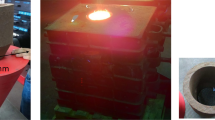A new efficient method of casting tubular billets by directional solidification without the use of a core is proposed making it possible to obtain a fine-grained dense structure of cast iron due to intensive onesided heat removal and excess supply to the solidification front of superheated liquid phase during the entire billet formation time in a metal water-cooled mold (crystallizer). It is shown that the method makes it possible to obtain a prescribed final cast iron structure by creating a certain cooling regime for castings outside the mold. In the positive effect of directional solidification of the melt inherited by iron a decisive role is played by the formation of a dense structure and a more dispersed carbide eutectic with a favorable carbide morphology, which determines the good cast iron wear resistance. The results of studies confirm that the new casting method provides production of workpieces with a prescribed phase composition and improved physical, mechanical, and operating properties. The effect is considered of various factors of the formation of workpieces from different types of cast iron: gray alloyed with lamellar graphite, high-strength and high-chromium, and also Niresist cast iron, on the structure, properties and service life of components for critical purposes of general, mining and oil refining engineering.











Similar content being viewed by others
References
B. N. Arzamasov (editor), Materials Science [in Russian] Izd. MGTU im. Baumana, Moscow (2008).
E. I. Marukovich, V. F. Bevza, and V. P. Grusha, “Fundamentally new effective process for casting hollow cast iron workpieces by directional solidification,” Lit’e Metall., No. 3, 21–24 (2010).
Y. I. Marukovich and U. F. Bevza, “Fundamentally new effective process, of casting of hollow cylindrical billets of cast iron by the method of directional solidification,” Key Engineering Materials, 457, 465–469 (2011).
S. E. Kodratyuk, “Steel structure and property inheritance,” Lit. Proizvod, No. 9, 6–10 (2008).
S. A. Sapozhnikov and B. M. Astashkevich, “Structure and properties of cast iron piston rings prepared by continuous-cyclic casting,” MiTOM, No. 3, 13–16 (2003).
E. I. Marukovich, V. F. Bevza, V. P. Grusha, and V. A. Krasnyi, “Formation of high-chromium castings in a watercooled metal mold,” Dvigatelestroenie, No. 1(255), 41–45 (2014).
A. M. Bodyako, S. V. Galagaev, A. A. Bodyako, and A. A. Suponev, “New possibilities of freezing method during cast iron casting,” Lit’e Metall., No. 3(52), 186–189 (2009).
E. I. Marukovich, V. F. Bevza, V. P. Grusha, and V. A. Krasnyi, “Improvement of operating properties of critical mining machine components made of alloyed cast iron,” Gorn. Ingor.-Anal. Byull., No. 10, 48–60 (2016).
A. V. Gilev, V. G. Chesnokov, N. B. Lavrova, et al., Bases of of Mining Machine and Equipment Operation [in Russian], SFU, Krasnoyarsk (2011).
A. D. Sherman and A. A. Zhukov (editors), Cast Iron, Handbook [in Russian], Metallurgiya, Moscow (1991).
V. N. Ivanovskii, V. I. Darishchev, A. A. Sabirov, et al., Borehole Pumping Units for Oil Recovery [in Russian], Izd. Neft’ i Gaz, Moscow (2002).
M. M. Rashidi and M. H. Idris, “Microstructure and mechanical properties of modified ductile Ni-resist with higher manganese content,” Mater. Sci. and Eng. A, 574, 226–234 (2013).
M. M. Rashidi and M. H. Idris, “The effects of solidification on the microstructure and mechanical properties of modified ductile Niresist iron with a high manganese content,” Mater. Sci. and Eng. A, 597, 395–407 (2014).
A. N. Rogotovskii and A. A. Shipel’nikov, “Features of Niresist modification for producing pumping unit castings,” Zagotov, Proizvod. Mashin., No. 9, 3–7 (2009).
N. A. Aleksandrov and N. S. Gushchin, “Effect of silicon and alloy modification on austenite stability during chromium cast iron cooling,” MiTOM, No. 7(613), 15–17 (2006).
Author information
Authors and Affiliations
Corresponding author
Additional information
Translated from Metallurg, Vol. 62, No. 6, pp. 36–44, June, 2018.
Rights and permissions
About this article
Cite this article
Bevza, V.F., Grusha, V.P. & Krasnyi, V.A. Use of Directional Solidification for Improving Tubular Workpiece Quality of Different Cast Irons. Metallurgist 62, 521–531 (2018). https://doi.org/10.1007/s11015-018-0689-8
Received:
Published:
Issue Date:
DOI: https://doi.org/10.1007/s11015-018-0689-8




